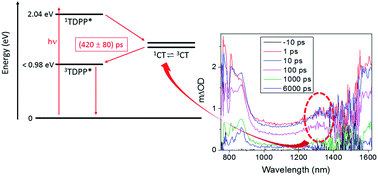当前位置:
X-MOL 学术
›
J. Mater. Chem. A
›
论文详情
Our official English website, www.x-mol.net, welcomes your feedback! (Note: you will need to create a separate account there.)
Ultra-fast spin-mixing in a diketopyrrolopyrrole monomer/fullerene blend charge transfer state
Journal of Materials Chemistry A ( IF 11.9 ) Pub Date : 2017-11-06 00:00:00 , DOI: 10.1039/c7ta07381j Enrico Salvadori 1, 2, 3, 4, 5 , Nathaniel Luke 2, 4, 6, 7 , Jordan Shaikh 2, 4, 6, 7 , Anastasia Leventis 2, 4, 6, 7 , Hugo Bronstein 2, 4, 6, 7 , Christopher W. M. Kay 1, 2, 3, 4, 5 , Tracey M. Clarke 2, 4, 6, 7
Journal of Materials Chemistry A ( IF 11.9 ) Pub Date : 2017-11-06 00:00:00 , DOI: 10.1039/c7ta07381j Enrico Salvadori 1, 2, 3, 4, 5 , Nathaniel Luke 2, 4, 6, 7 , Jordan Shaikh 2, 4, 6, 7 , Anastasia Leventis 2, 4, 6, 7 , Hugo Bronstein 2, 4, 6, 7 , Christopher W. M. Kay 1, 2, 3, 4, 5 , Tracey M. Clarke 2, 4, 6, 7
Affiliation

|
Diketopyrrolopyrrole (DPP) is one of the most common building blocks for small molecules and conjugated polymers designed for organic electronic applications. By attaining a detailed understanding of the photophysical behaviour for a simple DPP-based molecule in fullerene blends, we establish a foundation for spectroscopic investigations into more complex DPP-based systems. Transient absorption spectroscopy (TAS) and time-resolved electron paramagnetic resonance (TR-EPR) spectroscopy are used to examine bulk heterojunction blend films of a small diketopyrrolopyrrole-based molecule, 2,5-bis(2-hexyldecyl)-3,6-di(thiophen-2-yl)-2,5-dihydropyrrolo[3,4-c]pyrrole-1,4-dione (TDPP) with the common fullerene derivatives [6,6]-phenyl-C61-butyric acid methyl ester (PC60BM) and [6,6]-phenyl-C71-butyric acid methyl ester (PC70BM). Following pulsed laser excitation, the spectral signatures of a fullerene anion and a TDPP triplet state are observed on the picosecond timescale by TAS. The presence of these species implies the formation of a TDPP:PCBM charge transfer state that subsequently undergoes ultra-fast spin-mixing and geminate recombination to produce a TDPP triplet state. The overall photophysical mechanism is confirmed by TR-EPR spectroscopy, which unambiguously shows that the TDPP triplet is formed via spin-mixing in the TDPP:PCBM charge transfer state, rather than direct intersystem crossing from the excited singlet state.
中文翻译:

二酮基吡咯并吡咯单体/富勒烯共混物电荷转移状态下的超快速自旋混合
二酮吡咯并吡咯(DPP)是设计用于有机电子应用的小分子和共轭聚合物的最常见构建基块之一。通过对富勒烯共混物中简单的基于DPP的分子的光物理行为的详细了解,我们为更复杂的基于DPP的系统的光谱学研究奠定了基础。瞬态吸收光谱(TAS)和时间分辨电子顺磁共振(TR-EPR)光谱用于检查基于二酮吡咯并吡咯的小分子2,5-双(2-己基癸基)-3,6-的本体异质结共混膜二(噻吩-2-基)-2,5-二氢吡咯并[3,4- c ]吡咯-1,4-二酮(TDPP)与常见的富勒烯衍生物[6,6]-苯基-C 61-丁酸甲基酯(PC 60BM)和[6,6]-苯基-C 71-丁酸甲酯(PC 70 BM)。在脉冲激光激发之后,通过皮秒分析系统(TAS)在皮秒级的时间尺度上观察到了富勒烯阴离子和TDPP三重态的光谱特征。这些物质的存在意味着形成了TDPP:PCBM电荷转移状态,该电荷转移状态随后经历了超快速自旋混合和双键重组以产生TDPP三重态。TR-EPR光谱证实了整个光物理机制,它清楚地表明TDPP三重态是通过在TDPP:PCBM电荷转移状态下自旋混合形成的,而不是直接从激发单重态跃迁到系统间。
更新日期:2017-11-14
中文翻译:

二酮基吡咯并吡咯单体/富勒烯共混物电荷转移状态下的超快速自旋混合
二酮吡咯并吡咯(DPP)是设计用于有机电子应用的小分子和共轭聚合物的最常见构建基块之一。通过对富勒烯共混物中简单的基于DPP的分子的光物理行为的详细了解,我们为更复杂的基于DPP的系统的光谱学研究奠定了基础。瞬态吸收光谱(TAS)和时间分辨电子顺磁共振(TR-EPR)光谱用于检查基于二酮吡咯并吡咯的小分子2,5-双(2-己基癸基)-3,6-的本体异质结共混膜二(噻吩-2-基)-2,5-二氢吡咯并[3,4- c ]吡咯-1,4-二酮(TDPP)与常见的富勒烯衍生物[6,6]-苯基-C 61-丁酸甲基酯(PC 60BM)和[6,6]-苯基-C 71-丁酸甲酯(PC 70 BM)。在脉冲激光激发之后,通过皮秒分析系统(TAS)在皮秒级的时间尺度上观察到了富勒烯阴离子和TDPP三重态的光谱特征。这些物质的存在意味着形成了TDPP:PCBM电荷转移状态,该电荷转移状态随后经历了超快速自旋混合和双键重组以产生TDPP三重态。TR-EPR光谱证实了整个光物理机制,它清楚地表明TDPP三重态是通过在TDPP:PCBM电荷转移状态下自旋混合形成的,而不是直接从激发单重态跃迁到系统间。



























 京公网安备 11010802027423号
京公网安备 11010802027423号